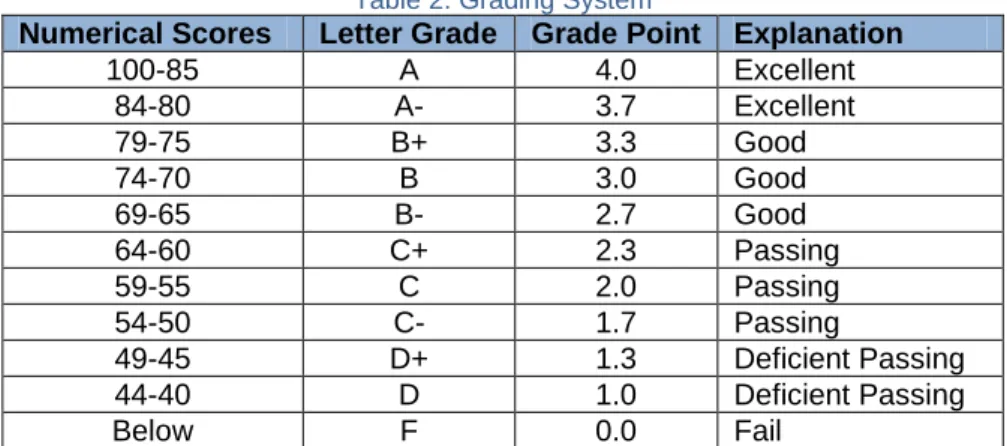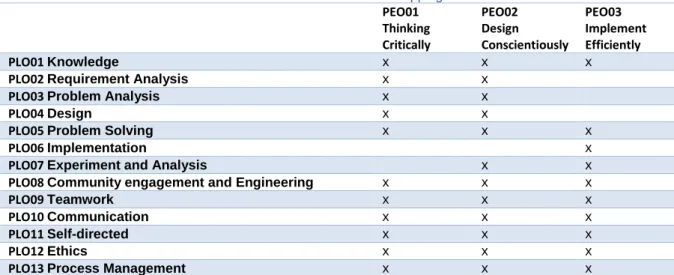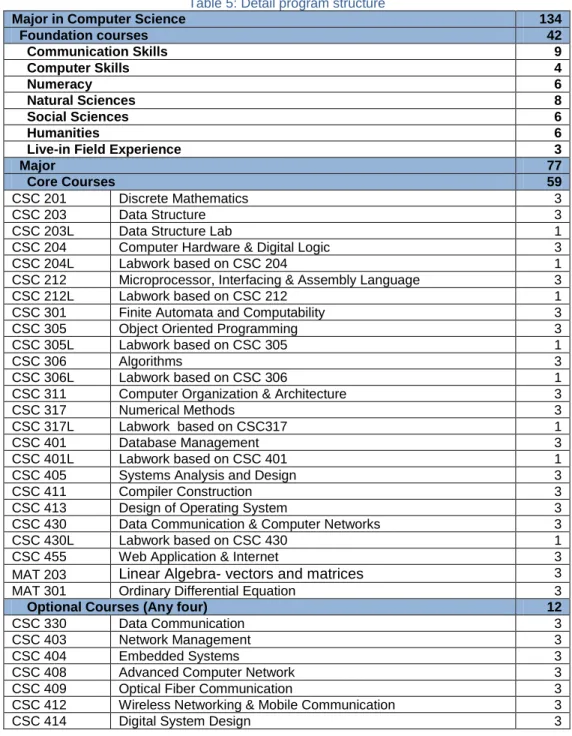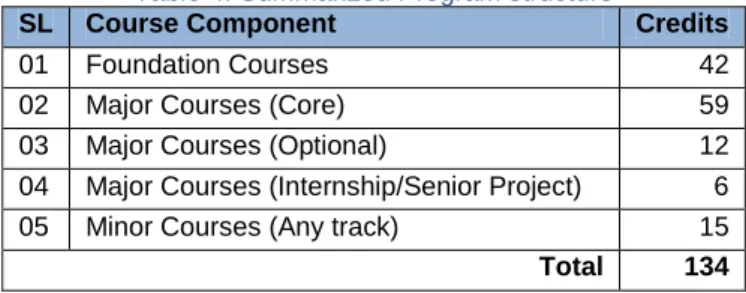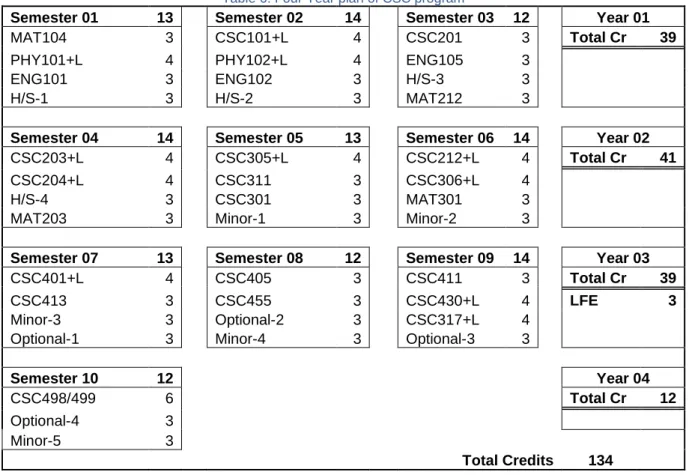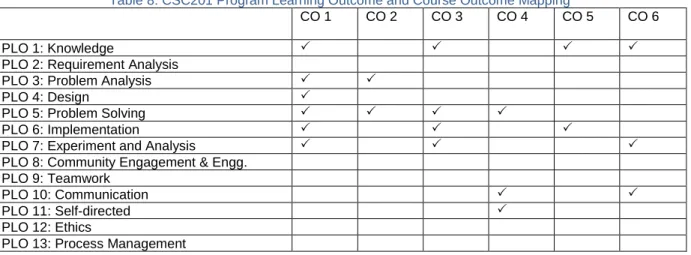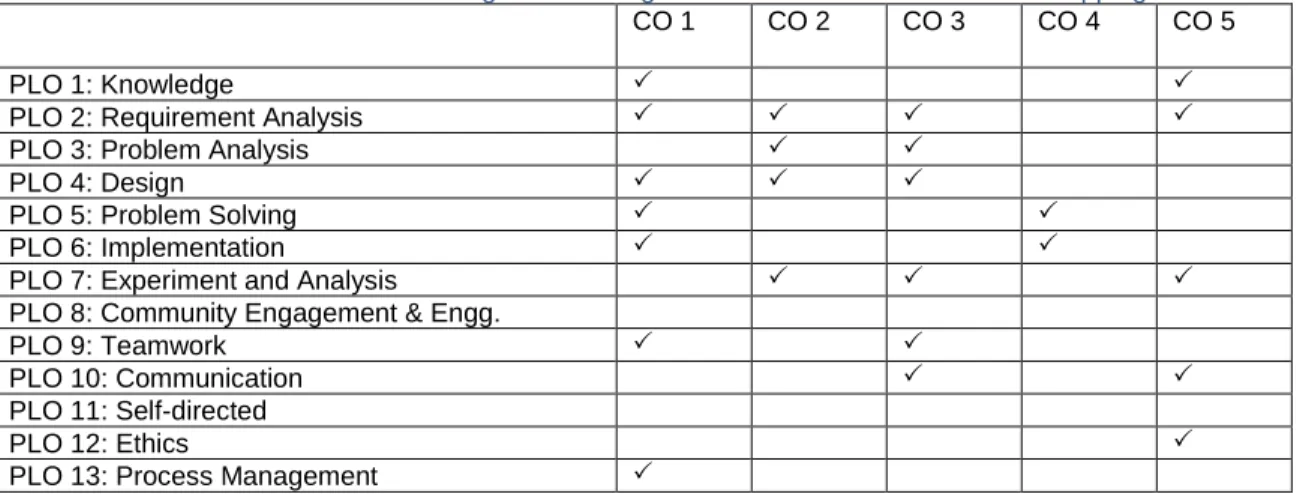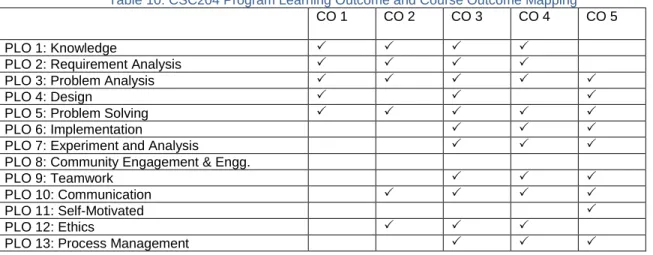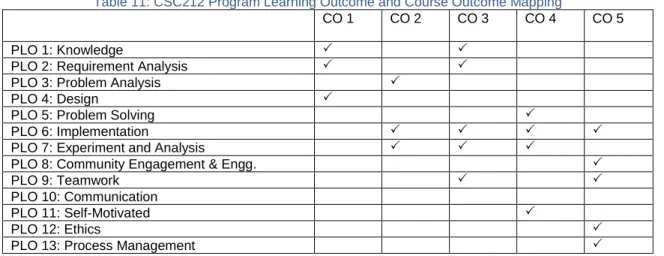Department of Computer Science & Engineering School of Engineering and Computer Science
Independent University, Bangladesh
Curriculum for
B Sc. in Computer Science
Version 7.2
Page 2 of 37
Revision record
Version Status Date Note
1.0 Approved by UGC with the approval of the university
Jul, 1993 Initial version prepared for program approval
2.0 Approved by Academic council
Mar, 1994 Changes in foundation and major courses
3.0 Approved by Academic council
Mar, 1999 Changes in foundation and major courses
4.0 Approved by Academic council
Mar, 2001 Changes in foundation and major courses
5.0 Approved by Academic council
Mar, 2006 Changes in foundation and major courses
6.0 Approved by Academic council
Mar 13, 2013
Changes in major and optional courses
7.0 Under review Jul 13, 2017 Update document for peer review along with outcome based education 7.1 Under review Dec 14, 2017 Incorporation of mapping with PLO
and CO 7.2 Under review Mar 19,
2017
Incorporation of departmental vision,
mission along with program Vision,
Mission and graduate profile
Page 3 of 37
T
ABLE OFC
ONTENTSTABLE OF CONTENTS ... 3
LIST OF TABLES: ... 4
DEPARTMENT OF COMPUTER SCIENCE AND ENGINEERING (CSE) ... 5
Introduction: ... 5
Vision: ... 5
Mission: ... 5
Admission Requirement ... 6
Semester/Term ... 6
Medium of Instruction ... 6
Teaching Strategy ... 6
Assessment Strategy: ... 7
Grading System... 7
Course Contact Hours ... 7
BACHELOR OF SCIENCE IN COMPUTER SCIENCE ... 7
Vision ... 7
Mission ... 8
Program Educational Objectives (PEO): ... 8
Program Learning Outcome (PLO): ... 8
PEO and PLO Mapping:... 9
Graduate Profile: ... 9
Structure of the program ... 10
Curriculum Layout: ... 10
Four Year Plan ... 12
Minor in Computer Science ... 12
Detail Course Description (Foundation) ... 13
Detail Course Description (Core) ... 13
Detail Course Description (Optional) ... 25
Page 4 of 37
L
IST OFT
ABLES:Table 1: General evaluation criteria ... 7
Table 2: Grading System ... 7
Table 3: PEO and PLO mapping ... 9
Table 4: Summarized Program structure ... 10
Table 5: Detail program structure ... 10
Table 6: Four Year plan of CSC program ... 12
Table 7: CSC101 Program Learning Outcome and Course Outcome Mapping ... 13
Table 8: CSC201 Program Learning Outcome and Course Outcome Mapping ... 14
Table 9: CSC203 Program Learning Outcome and Course Outcome Mapping ... 15
Table 10: CSC204 Program Learning Outcome and Course Outcome Mapping... 15
Table 11: CSC212 Program Learning Outcome and Course Outcome Mapping... 16
Table 12: CSC301 Program Learning Outcome and Course Outcome Mapping... 17
Table 13: CSC305 Program Learning Outcome and Course Outcome Mapping... 17
Table 14: CSC306 Program Learning Outcome and Course Outcome Mapping... 18
Table 15: CSC311 Program Learning Outcome and Course Outcome Mapping... 18
Table 16: CSC317 Program Learning Outcome and Course Outcome Mapping... 19
Table 17: CSC401 Program Learning Outcome and Course Outcome Mapping... 20
Table 18: CSC405 Program Learning Outcome and Course Outcome Mapping... 21
Table 19: CSC411 Program Learning Outcome and Course Outcome Mapping... 21
Table 20: CSC413 Program Learning Outcome and Course Outcome Mapping... 22
Table 21: CSC430 Program Learning Outcome and Course Outcome Mapping... 23
Table 24: CSC455 Program Learning Outcome and Course Outcome Mapping... 24
Table 22: MAT203 Program Learning Outcome and Course Outcome Mapping... 24
Table 23: MAT 301 Program Learning Outcome and Course Outcome Mapping... 25
Page 5 of 37
D
EPARTMENT OFC
OMPUTERS
CIENCE ANDE
NGINEERING(CSE)
INTRODUCTION:
Bangladesh has seen remarkable growth in the ICT sector in recent times and IUB’s Computer Science & Engineering (CSE) Department is an active participant in this growth. The Department of Computer Science & Engineering (CSE) at IUB, under the School of Engineering and Computer Science (SECS), is one of the most dynamic and versatile departments in the university. Our
“Application Oriented Learning” philosophy not only teaches students the fundamental principles of computing but also provides them with hands-on training of the various applications of this knowledge.
University Grants Commission (UGC) of Bangladesh recognizes this contribution and potential and has provided financial support in excess of Four Crore Taka to develop advanced research facilities.
We have arguably the best IT research setup in Bangladesh. 11 Tera Flops GPU server for High- Performance Computing research lab (Center for Cognitive Skill Enhancement), digital fabrication facilities enabled research lab (Fab Lab, IUB), state-of-the-art Robotics and Networking Labs, Electronics and Electrical Circuits laboratories for smart circuit design research, to mention just a few of our facilities.
We offer comprehensive Computer Science and Engineering based curriculums both at the undergraduate and graduate level. Students can mound their education according to their desired research or industry track. The CSE department provides the opportunity to explore specialized topics in Machine Learning, Computer Vision, Data Science, Big Data, Robotics, Software Engineering, Network Administration, Game Development, Cyber Security, and follow the latest and greatest trends in the IT world.
The Department of Computer Science and Engineering offers a 4 (four) year Bachelors of Science program in Computer Science. The degree is designed to provide a deep and broad knowledge of the theory and practical application related to computer systems. The university is distinctive in its emphasis on a broad based liberal arts curriculum based on a North American model. The mission of the university is to deliver a high quality education which will help foster thinking across disciplines, encourage tolerance and understanding of diverse cultural and social traditions, nurture essential values and prepare students for a fast changing world. Department of CSE challenged the students to think critically, encouraged to imagine boldly and guided to implement efficiently.
VISION:
Inspired by the mission of the university, the department of Computer Science and Engineering is striving to create a breed of students who can imagine boldly, think clearly, argue precisely and implement efficiently. Our mission is to perform high impact research leading to sustainable innovation in the area of computer science and engineering thus contributing to the economic growth of the country through a meaningful partnership between the Community, the Industry and the University.
MISSION:
At the very heart of science and technology education lie comprehension, imagination and implementation. The objective of our programs is to contribute in creating a globally recognized and locally sustainable knowledge eco-system through which students will graduate to provide leadership in industry, enterprise, public service and welfare; to encourage and support innovative research;
create enthusiasm in learning through hands on training; while creating knowledge throughout the process. We also provide a platform for lifelong learning through graduate programs and continuing education endeavors.
The curriculum objectives for the undergraduate education are to teach communicative skills (oral and written communication) with a strong humanities background through a thorough liberal arts foundation. To have students have a comprehensive understanding of Computer Science and Engineering related subjects (i.e. a major), and a sub-specialization (minor) in a subject of student’s own interest and appreciate their inter-connectivity with founding principles. Focus is maintained on outcome based learning. Outcome is quantifiable through students’ enhanced skill in comprehension, analytical capability and decision making skill.
The undergraduate programs equip students with the tools needed to become innovators and global leaders in computing and equip them with the background necessary to pursue higher studies.
Consequently our programs are designed to have a high impact outcome of contributing to the sustainable development of knowledge-based economy of our nation.
Page 6 of 37 ADMISSION REQUIREMENT
Below we provide the admission requirements of the School of Engineering and Computer Science for the Computer Science and Engineering degree program.
Combined GPA of 8.0 in S.S.C and H.S.C. with minimum 3.5 in each.
O’Level in minimum 5 subjects with a GPA 2.50 and A’Level in 2 subjects with a minimum GPA 2.00
International Baccalaureate or High School Diploma
For other 12 years equivalent degrees must have the equivalence certificate from Ministry of Education.
Students must have Math and Physics in their H.S.C. with at least B grade.
All eligible candidates will have to tale a written admission test in English, Math and Physics before final selection into the program.
SEMESTER/TERM
There are three academic semesters namely, Autumn, Spring and Summer. The duration of each semester is about four (4) months.
The admission procedure for Autumn (the beginning of the academic year) starts within the first week of July and ends with the commencement of classes in the second /third week of August. The semester ends by the end of December. The admission procedure for Spring starts within the first week of December and the commencement of classes in the January. The semester ends on April.
The Summer class begins on May and ends on August.
MEDIUM OF INSTRUCTION
English is the medium of instruction at the university.
TEACHING STRATEGY
The Department of CSE believes in extra-ordinary quality teaching in a local university with a global connection. The Department is concern about the variance among the same-level teachers taking similar courses at undergraduate level, hence focuses on eliminating these differences and discriminations as much as possible that have negative implications on students’ learning. It also tries to equate the learning outputs from the same courses and make a unitary approach toward tertiary- level education by conducting trainings and workshops on assessment, measurement, evaluation and other pedagogical instruments. In general, the faculty members use four broad styles, i.e. formal authority, demonstrator or personal model, facilitator and delegator. In next few lines some commonly practiced teaching strategies have been listed:
Lecture
Demonstration
Reading Assignment
Individual Project/Assignment
Group Assignment
Small Group Discussion
Panel Discussion
Videotapes
Debate
Simulation Game
Brainstorming
Case Studies
Role Playing
Seminar/Workshop
Cooperative Learning
Problem-based Learning (PBL)
Inquiry-based Learning (IBL)
Page 7 of 37 ASSESSMENT STRATEGY:
At CSE, two types of assessments are in practice; formative assessment for continuous improvement of the students’ learning, summative assessment for grading of students’ performance. Generally, CSE believes in assessment for learning, not assessment of learning. Principally the assessment is the responsibility of the individual faculty members according to the standard of North American academia. However, for courses with multiple sections a faculty coordinator mediates the process of assessment. Each course is assessed over a total of 100 numeric marks which is divided into two categories. Continuous assessment, such as quizzes, presentation, class test, etc. covers 40% to 60%
while the rest of the marks are allocated for the mid-term and final exams. In some courses, rigorous assignments may replace other forms of assessments. There are no specific criteria for assessing the performance of the students; however, the following criteria are often used for different courses:
Table 1: General evaluation criteria
Criteria Weight
Class Tests 20
Assignments 20
Midterm 25
Final 35
Total 100
*Student must attend at least 75% classes to get a valid grade.
GRADING SYSTEM
The grading scale in CSE is in line with the IUB’s grading system. However, the numeric score for the corresponding letter grade is not a fixed structure, rather a guideline. Following is the prescribed grading structure at CSE:
Table 2: Grading System
Numerical Scores Letter Grade Grade Point Explanation
100-85 A 4.0 Excellent
84-80 A- 3.7 Excellent
79-75 B+ 3.3 Good
74-70 B 3.0 Good
69-65 B- 2.7 Good
64-60 C+ 2.3 Passing
59-55 C 2.0 Passing
54-50 C- 1.7 Passing
49-45 D+ 1.3 Deficient Passing
44-40 D 1.0 Deficient Passing
Below F 0.0 Fail
COURSE CONTACT HOURS
For each course students attend 2 classes each week total 3 hours a week. Each lab course is 1 credit course and students need to attend 1 class each week total 1.5 hrs a week.
B
ACHELOR OFS
CIENCE INC
OMPUTERS
CIENCEComputer science is the base and platform for countless industries and disciplines. The Bachelor of Science in Computer Science program prepares students to leave school with the tools needed to become innovators with great problem-solving skills and global leaders in computing. Common roles for graduates include computer programmer, software designer and engineer, financial analyst and scientific researcher.
VISION
To become a recognized Computer Science program in teaching computing workforce and represent as a promoter of the computer centric society in Bangladesh, as well as around the world.
Page 8 of 37 MISSION
The mission is to create facilities and expertise in advanced Computer Science program by providing exposure of latest tools and technologies in the area of engineering and technology. The goal is to enrich society with advance computer and information science by producing graduates who have the knowledge, ability, and skill to become innovators and leaders in order to contribute to the aspirations of the country, nation and the world. The target is also to encourage students to become self- motivated, problem solving individuals who can find and understand the knowledge needed to be successful in Computer Science field.
PROGRAM EDUCATIONAL OBJECTIVES (PEO):
PEO01THINK CRITICALLY:
Our education system is more geared towards making the students acquiring knowledge but fails to capture their imagination. We want to change that by introducing the students to the exciting world of logic, rationalization and decision making through games and apps. We will introduce our students to various development, analysis and synthesis tools and will engage them in research early in their studies.
PEO2:DESIGN CONSCIENTIOUSLY
A broad liberal arts curriculum covering computer science as well as related technical subjects will provide students with a deeper understanding of the engineering issues and trade-offs that cross disciplines. Courses in humanities and social sciences will equip them with the knowledge and awareness to become responsible members of society who understand the social, political, economic and environmental impact of their decisions. Graduates will become ethical professionals with the ability to work individually or in multidisciplinary teams to design sustainable solutions to complex real- world problems under real-world constraints.
PEO3:IMPLEMENT EFFICIENTLY
A strong emphasis is placed on developing the students’ ability to identify and analyze a problem, and to then define the computing requirements appropriate to its solution with regard to factors such as efficiency, sustainability, scalability, available resources and constraints. We ensure that our students are kept up-to-date with knowledge and practice of the most current tools and techniques, and that they develop an appreciation for continued improvement through self-training or formal graduate study.
Graduates will possess the ability to design and implement efficient and future-proof software solutions to problems of varying sizes and complexities using modern software development principles and practices.
PROGRAM LEARNING OUTCOME (PLO):
The learning outcome of the degree program supports all the outcomes suggested in the ABET criteria.
1. Knowledge: An ability to select and apply the knowledge, techniques, skills, and modern tools of the computer science and engineering discipline;
2. Requirement Analysis: An ability to identify, analyze, and solve a problem by defining the computing requirements of the problem through effectively gathering of the actual requirements;
3. Problem Analysis: An ability to select and apply the knowledge of mathematics, science, engineering, and technology to computing problems that require the application of principles and applied procedures or methodologies;
4. Design: An ability to design computer based systems, components, or processes to meet the desire requirement;
5. Problem Solving: An ability to apply mathematical foundations, simulation, algorithmic principles, and computer science theory in the modeling and design of computer-based systems in a way that demonstrates comprehension of the tradeoffs involved in design choices.
6. Implementation: An ability to apply design and development principles in the construction of software systems of varying complexity
Page 9 of 37 7. Experiment and Analysis: An ability to conduct standard tests and measurements; to conduct, analyze, and interpret experiments; and to apply experimental results to improve solutions (products or processes);
8. Community engagement and Engineering: An ability to appreciate human behavior, culture, interaction and organization through studies in the humanities and social sciences. A knowledge of the impact of computing solutions in a local and global context;
9. Teamwork: An ability to function effectively as a member or leader of a technical team to accomplish common goals;
10. Communication: An ability to apply written and oral communication in both technical and non- technical environments; an ability to communicate with a range of audience; and an ability to identify and use appropriate available technical literature;
11. Self-directed: Recognition of the need for and an ability to engage in self-directed continuing professional development; be prepared to enter a top-ranked graduate program in Computer Science and Engineering.
12. Ethics: An understanding of and a commitment to address professional, ethical, legal, security, social issues and responsibilities including a respect for diversity;
13. Process Management: A commitment to quality, timeliness, and continuous improvement.
PEO AND PLOMAPPING:
Table 3: PEO and PLO mapping PEO01 Thinking Critically
PEO02 Design Conscientiously
PEO03 Implement Efficiently
PLO01 Knowledge x x x
PLO02 Requirement Analysis x x
PLO03 Problem Analysis x x
PLO04 Design x x
PLO05 Problem Solving x x x
PLO06 Implementation x
PLO07 Experiment and Analysis x x
PLO08 Community engagement and Engineering x x x
PLO09 Teamwork x x x
PLO10 Communication x x x
PLO11 Self-directed x x x
PLO12 Ethics x x x
PLO13 Process Management x x x
GRADUATE PROFILE:
The followings are the graduate profile of the department of Computer Science and Engineering.
1. Scholars: Our graduates are expected to have a broad knowledge-base and disciplinary expertise.
2. Problem Solvers: With an adequate knowledge of disciplinary expertise and problem domain our graduates will be in a position to formalize any problem and solve that in a methodical way.
3. Innovators: We want our graduates to be focused on future-proof solution. They will be critical thinkers, creative designers and efficient makers. They are capable of developing unique and sustainable solutions to the real world problems.
4. Leaders: Graduates of our department will take personal responsibility and seek opportunities to work with others to advance thinking and achievement in all spheres of their lives. They are confident, inclusive, inspiring and influential.
5. Global Citizens: Our graduates are locally produced but globally in demand. They are aware of global issues and act with integrity, sensitivity and fluency across cultures and perspectives, and are committed to the betterment of the society as a whole.
Page 10 of 37 STRUCTURE OF THE PROGRAM
In order to obtain a B.Sc. in Computer Science student must complete a minimum of 134 credits of coursework. This includes 42 credits of Foundation studies. The minimum requirement for the major is 77 credit hours including 6 credit hours for internship/senior project.
Table 4: Summarized Program structure
SL Course Component Credits
01 Foundation Courses 42
02 Major Courses (Core) 59
03 Major Courses (Optional) 12
04 Major Courses (Internship/Senior Project) 6
05 Minor Courses (Any track) 15
Total 134
CURRICULUM LAYOUT:
Below we provide the detail break-down of the program structure as curriculum layout.
Table 5: Detail program structure
Major in Computer Science 134
Foundation courses 42
Communication Skills 9
Computer Skills 4
Numeracy 6
Natural Sciences 8
Social Sciences 6
Humanities 6
Live-in Field Experience 3
Major 77
Core Courses 59
CSC 201 Discrete Mathematics 3
CSC 203 Data Structure 3
CSC 203L Data Structure Lab 1
CSC 204 Computer Hardware & Digital Logic 3
CSC 204L Labwork based on CSC 204 1
CSC 212 Microprocessor, Interfacing & Assembly Language 3
CSC 212L Labwork based on CSC 212 1
CSC 301 Finite Automata and Computability 3
CSC 305 Object Oriented Programming 3
CSC 305L Labwork based on CSC 305 1
CSC 306 Algorithms 3
CSC 306L Labwork based on CSC 306 1
CSC 311 Computer Organization & Architecture 3
CSC 317 Numerical Methods 3
CSC 317L Labwork based on CSC317 1
CSC 401 Database Management 3
CSC 401L Labwork based on CSC 401 1
CSC 405 Systems Analysis and Design 3
CSC 411 Compiler Construction 3
CSC 413 Design of Operating System 3
CSC 430 Data Communication & Computer Networks 3
CSC 430L Labwork based on CSC 430 1
CSC 455 Web Application & Internet 3
MAT 203 Linear Algebra- vectors and matrices 3
MAT 301 Ordinary Differential Equation 3
Optional Courses (Any four) 12
CSC 330 Data Communication 3
CSC 403 Network Management 3
CSC 404 Embedded Systems 3
CSC 408 Advanced Computer Network 3
CSC 409 Optical Fiber Communication 3
CSC 412 Wireless Networking & Mobile Communication 3
CSC 414 Digital System Design 3
Page 11 of 37
CSC 416 Distributed Database Systems 3
CSC 417 Data Mining and Warehouse 3
CSC 418 Database Systems Implementation 3
CSC 419 Advanced Database Management Systems 3
CSC 420 Image Processing 3
CSC 421 Machine learning 3
CSC 422 Pattern Recognition 3
CSC 423 Theory of Fuzzy Systems 3
CSC 424 Neural Networks 3
CSC 425 Artificial Intelligence 3
CSC 426 Introduction to Robotics 3
CSC 431 Advanced Object Oriented Programming 3
CSC 434 Advance Programming in UNIX 3
CSC 435 Computer Graphics 3
CSC 437 Theory of Computation & Automata 3
CSC 440 Computer Simulation and Modeling 3
CSC 441 Instrumentation & measurements 3
CSC 443 Digital Signal Processing 3
CSC 444 Digital Electronics and Pulse Techniques 3
CSC 445 Software Engineering 3
CSC 447 Computer Peripherals & Interfacing 3
CSC 449 Fault Tolerant System 3
CSC 450 Cryptography and Network Security 3
CSC 452 Software Marketing 3
CSC 453 Software Requirement Engineering 3
CSC 454 Software Engineering Process Management 3
CSC 456 Business Process Reengineering 3
CSC 457 Project Management 3
CSC 458 Software Quality and Testing 3
CSC 459 Software Architecture and Component-Based Design 3
CSC 460 Multimedia Systems 3
CSC 461 Advance topics for Application Development 3
CSC 462 Entrepreneurship Development 3
CSC 463 IT Forensic 3
CSC 465 E-commerce and Web Database 3
CSC 470 Introduction to Parallel Programming 3
CSC 475 VLSI Design & Testing 3
CSC 480 Computer Vision 3
CSC 485 Telecommunication Engineering 3
CSC 490 Special Topics in Computer Science 3
MAT 401 Graph Theories 3
MAT 403 Introduction to Mathematical Modeling 3
MAT 405 Optimisation Techniques 3
MAT 420 Computational Geometry 3
MAT 430 Introduction to Discrete Dynamical Systems 3
Internship Program or Senior Project 6
CSC 4** Any Optional Course 3
CSC 498 Senior project 6
CSC 499 Internship Program 3
Minor/Specialization 15
Page 12 of 37 FOUR YEAR PLAN
The following table provides an example of how to progress with Computer Science major program.
However, the actual structure should be followed according to the Green Book and Computer Science curriculum.
Table 6: Four Year plan of CSC program
Semester 01 13 Semester 02 14 Semester 03 12 Year 01
MAT104 3 CSC101+L 4 CSC201 3 Total Cr 39
PHY101+L 4 PHY102+L 4 ENG105 3
ENG101 3 ENG102 3 H/S-3 3
H/S-1 3 H/S-2 3 MAT212 3
Semester 04 14 Semester 05 13 Semester 06 14 Year 02
CSC203+L 4 CSC305+L 4 CSC212+L 4 Total Cr 41
CSC204+L 4 CSC311 3 CSC306+L 4
H/S-4 3 CSC301 3 MAT301 3
MAT203 3 Minor-1 3 Minor-2 3
Semester 07 13 Semester 08 12 Semester 09 14 Year 03
CSC401+L 4 CSC405 3 CSC411 3 Total Cr 39
CSC413 3 CSC455 3 CSC430+L 4 LFE 3
Minor-3 3 Optional-2 3 CSC317+L 4
Optional-1 3 Minor-4 3 Optional-3 3
Semester 10 12 Year 04
CSC498/499 6 Total Cr 12
Optional-4 3
Minor-5 3
Total Credits 134
MINOR IN COMPUTER SCIENCE
There are two options of computer science minor. The first variant is oriented on hardware and the second variant concentrates on development of programming skill. Students must complete the prerequisites of the courses. Students must complete minimum 15 (fifteen) credits to complete minor in Computer Science.
VARIANT 1:
CSC204+L, CSC 212+L, CSC311 and CSC430+L.
VARIANT 2:
CSC203+L, CSC305+L, CSC306+L and CSC401+L
Page 13 of 37 DETAIL COURSE DESCRIPTION (FOUNDATION)
CSC101INTRODUCTION TO COMPUTER PROGRAMMING
Introduction to computer program using a high level programming language (using object oriented approach). Topics to be covered are Identifiers; Data types; Variable; Constants; Different operators;
Basic Input Output; Control structures i.e., Conditional statements, Loops; Array; Functions; String.
Primary emphasis is given to problem solving approach; Algorithm design and program development.
Programming Language C++, Java. (Prerequisite: MAT104 with minimum B-) Text Books:
C++ How to Program by Deitel & Deitel.
Beginning C++ the complete language by Ivor Horton.
CSC101LLABWORK BASED ON CSC101 Course Outcome (CO):
CO1. Reason about interleaved statements operating on a shared data structure
CO2. Reason about compile errors, common runtime errors (e.g. NullPE) and logical errors in given short code segments (1-10 lines)
CO3. Reason about short-circuiting & different code paths for different data CO4. Reason about computational cost, and return values
CO5. Use an industry-standard fully-featured modern IDE (e.g. Visual Studio, CodeBlocks) as a development tool.
Table 7: CSC101 Program Learning Outcome and Course Outcome Mapping
CO 1 CO 2 CO 3 CO 4 CO 5
PLO 1: Knowledge
PLO 2: Requirement Analysis
PLO 3: Problem Analysis
PLO 4: Design
PLO 5: Problem Solving
PLO 6: Implementation
PLO 7: Experiment and Analysis
PLO 8: Community Engagement & Engg.
PLO 9: Teamwork
PLO 10: Communication PLO 11: Self-directed PLO 12: Ethics
PLO 13: Process Management
DETAIL COURSE DESCRIPTION (CORE) CSC201DISCRETE MATHEMATICS
Proposition, first order logic, basic logical operations, truth tables, tautologies, contradictions, algebra of propositions, logical implications, logical equivalence, predicates, universal and existential quantifiers. Valid and invalid arguments. Proof of strategies (direct proofs, indirect proofs, proof by contradictions, proof by cases), mathematical induction. Review of set operations, Venn diagrams, basic identities on sets, Cartesian products. Basic definitions of relations, representation of relations, closures, equivalence relations, partial orderings. Basic definitions of functions, injective, surjective and bijective functions, inverse functions, composition of functions, recursively defined functions, countable and uncountable, sets, sequences and sums, recursively defined functions, matrices.
Divisibility and modular arithmetic, greatest common divisors, Euclidean algorithm. Basics of counting, pigeonhole principle, permutations and combinations, generalized permutations and combinations, inclusion-exclusion, recurrence relations, solving recurrence relations, generating functions.
Semigroups, monoid, groups, subgroups, cyclic groups, permutation groups, homomorphism and isomorphism of groups, rings and fields. Finite state machines, finite automata, languages and grammars. (Prerequisite: CSC 101 with minimum B-)
Page 14 of 37 Text book:
Discrete Mathematics and its Applications by K. Rosen Course Outcome (CO):
CO1. Derive big-O running time for simple pseudocode examples, especially recursive examples.
Includes finding closed-forms for recursively-defined formulas using unrolling and recursion trees CO2. Write inductive proofs, including proofs on trees
CO3. Apply predicate logic: determine the truth of statements, perform simple transformations (esp.
negation), accurately apply formal definitions (esp. vacuous truth cases, attention to variable types and scope)
CO4. Write literate proofs using straightforward application of standard outlines (direct, contrapositive, contradiction, upper/lower bounds).
CO5. State and apply basic definitions, facts, and notation for commonly used discrete math constructs
CO6. Classify the complexity of very simple examples in terms of countable versus uncountable, polynomial versus exponential, decidable versus undecidable
Table 8: CSC201 Program Learning Outcome and Course Outcome Mapping
CO 1 CO 2 CO 3 CO 4 CO 5 CO 6
PLO 1: Knowledge
PLO 2: Requirement Analysis
PLO 3: Problem Analysis
PLO 4: Design
PLO 5: Problem Solving
PLO 6: Implementation
PLO 7: Experiment and Analysis
PLO 8: Community Engagement & Engg.
PLO 9: Teamwork
PLO 10: Communication
PLO 11: Self-directed
PLO 12: Ethics
PLO 13: Process Management
CSC203DATA STRUCTURE
Elementary data structure: Elements of data representation and storage. Arrays and Linked Lists (singly linked list and doubly linked list). Abstract data types: Stack, Queue, Priority Queue.
Comparative analysis of different implementations of ADTs (Array based and linked list based). BST (Binary Search tree), Heap. Efficient Priority Queue (Heap based). Complexity analysis of dictionary operations (Insertion/Deletion/search) on ADTs. Data structure as a facilitator of smart searching and sorting algorithms (Binary search, Heap sort). Graphs (Connectivity graph, Directed and Undirected graph). Balanced search tree: Red Black Tree. (Prerequisite: CSC 101 with minimum B-)
Text Books:
Data Structures & Algorithms by Aho, Ullman, Hopcroft
C++ plus Data Structure 5th edition by Nell Dale
Data Structures and Their Algorithms by H. Lwis, L. Dennenberg CSC203LLABWORK BASED ON CSC203
Course Outcome(CO):
CO1: Navigate, organize, compile C++ projects of moderate complexity (many objects and dependencies)
CO2: Decompose a problem into its supporting data structures such as lists, stacks, queues, trees, etc.
CO3: Diagnose appropriate approaches or algorithms to solve problems involving graph search, tree traversal, optimization, data organization, etc., together with appropriate data structures.
Page 15 of 37 CO4: Implement classic and adapted data structures and applications.
CO5: Analyze the efficiency of implementation choices.
Table 9: CSC203 Program Learning Outcome and Course Outcome Mapping
CO 1 CO 2 CO 3 CO 4 CO 5
PLO 1: Knowledge
PLO 2: Requirement Analysis
PLO 3: Problem Analysis
PLO 4: Design
PLO 5: Problem Solving
PLO 6: Implementation
PLO 7: Experiment and Analysis
PLO 8: Community Engagement & Engg.
PLO 9: Teamwork
PLO 10: Communication
PLO 11: Self-directed
PLO 12: Ethics
PLO 13: Process Management
CSC204INTRODUCTION TO COMPUTER HARDWARE AND DIGITAL LOGIC
Digital and analog systems. Number systems and codes; logic gates, Boolean algebra, arithmetic circuits, latches, register, counters, MSI logic circuits, flip-flops, A-D and D-A converters, IC logic families, memory devices, PLD, ASIC, FPGA. (Prerequisite: PHY 102, CSC101 with minimum B-) Text Book:
Digital Systems by Ronald J. Tocci CSC204LLABWORK BASED ON CSC204 Course Outcome(CO):
CO1: Understand and be able to demonstrate fundamental concepts and techniques used in digital electronics.
CO2: Appreciate the structure of various number systems and its application in digital design.
CO3: Understand, analyze and design various combinational and sequential circuits.
CO4: Identify and analyze various hazards and timing problems in a digital design.
CO5: Build and analyze digital circuits.
Table 10: CSC204 Program Learning Outcome and Course Outcome Mapping
CO 1 CO 2 CO 3 CO 4 CO 5
PLO 1: Knowledge
PLO 2: Requirement Analysis
PLO 3: Problem Analysis
PLO 4: Design
PLO 5: Problem Solving
PLO 6: Implementation
PLO 7: Experiment and Analysis
PLO 8: Community Engagement & Engg.
PLO 9: Teamwork
PLO 10: Communication
PLO 11: Self-Motivated
PLO 12: Ethics
PLO 13: Process Management
CSC212MICROPROCESSOR,INTERFACING AND ASSEMBLY LANGUAGE
Organization of a computer. Introduction to 80X 86 families of microprocessors; Microprocessor Architecture, addressing mechanism, Instruction set, Instruction format. Assembly Language
Page 16 of 37 programming: assembling, linking, running and debugging programs. Controlling program development; Interrupt system. Microprocessor interfacing with memory and other devices. 8086 based system design, Programmable peripheral Interface: 8255A, 8251A, DMA controller 8237, Interrupt controller 8259A. Overview of advanced processors: 80386, Pentium and Multicore processors. (Prerequisite: CSC 311)
Text Books:
Microprocessors and Microcomputer-Based System Design, Mohamed Rafiquzzaman
The Intel Microprocessors by Barry B. Brey CSC212LLABWORK BASED ON CSC212
Course Outcome(CO):
CO1: Analyze and understand bus/interface structures.
CO2: Characterize the timing/performance behavior of interfaces.
CO3: Utilize Assembly language programs to gain insight into instructions and machine-level operations.
CO4: Program and debug microprocessor devices.
CO5: Control/use peripherals, devices, and buses.
Table 11: CSC212 Program Learning Outcome and Course Outcome Mapping
CO 1 CO 2 CO 3 CO 4 CO 5
PLO 1: Knowledge
PLO 2: Requirement Analysis
PLO 3: Problem Analysis
PLO 4: Design
PLO 5: Problem Solving
PLO 6: Implementation
PLO 7: Experiment and Analysis
PLO 8: Community Engagement & Engg.
PLO 9: Teamwork
PLO 10: Communication
PLO 11: Self-Motivated
PLO 12: Ethics
PLO 13: Process Management
CSC301FINITE AUTOMATA AND COMPUTABILITY
Basic notions: string, prefix, suffix, substring, concatenation; Cardinality; Distinction between uncountable and countable infinite. Different proof techniques: Proof by construction, proof by contradiction, pigeon hole principle. Deterministic and non-deterministic Finite state automata;
Regular language, regular expression. Equivalence of NFA and DFA. Pumping Lemma, non regular languages. Context free grammar (CFG) and Push down automata (PDA). Chomsky Normal form.
Parsing. Turing machine. Universal Turing machine and Halting problem. Goedel numbering.
Computability. P/NP. (Prerequisite: CSC 201) Text Books:
Elements of the Theory of Computation 2nd Edition. by H. Lewis, C. Papadimitriou
Introduction to the Theory of Computation by M. Sipser
Introduction to Automata Theory, languages & Computation 3rd Edition by J. Hopcroft, R.
Motwani, J. Ullman Course Outcome(CO):
CO1: Define and describe formal models of computation, such as finite automata, pushdown automata, and Turing machines.
CO2. Demonstrate understanding of key notions, such as algorithm, computability, decidability, and complexity through problem solving.
Page 17 of 37 CO3. Convert between finite automata, regular grammars, and regular expression representations of regular languages.
CO4. Apply the pumping lemma for regular languages to determine if a language is regular.
CO5.Convert between grammars and push-down automata for context-free languages.
CO6. Apply learned concepts to create proofs regarding the computational complexity of various problems.
Table 12: CSC301 Program Learning Outcome and Course Outcome Mapping
CO 1 CO 2 CO 3 CO 4 CO 5 CO 6
PLO 1: Knowledge
PLO 2: Requirement Analysis
PLO 3: Problem Analysis
PLO 4: Design
PLO 5: Problem Solving
PLO 6: Implementation
PLO 7: Experiment and Analysis
PLO 8: Community Engagement & Engg.
PLO 9: Teamwork PLO 10: Communication PLO 11: Self-directed PLO 12: Ethics
PLO 13: Process Management
CSC305OBJECT-ORIENTED PROGRAMMING
Objects and classes; Constructors and destructor; Abstract Data Structures, Function chaining; Friend functions; Function and operator overloading; Composition and Inheritance; Dynamic polymorphism using virtual functions; Exception handling; Template functions and classes; Standard Template Library; Programming Languages C++/ Java/ C#. (Prerequisite: CSC 203)
Text Books:
Ivor Horton's Beginning Visual C++ 2013, by Ivor Horton, Wrox Publication
Ivor Horton's Beginning Java, Java 7, by Ivor Horton, Wrox Publication CSC305LLABWORK BASED ON CSC305
Course Outcome(CO):
CO1: Understand the benefits of object oriented design and when it is an appropriate methodology to use.
CO2: Design, write and test programs that make appropriate use of advanced object-oriented facilities common to object-oriented languages such as overloading and inheritance.
CO3: Manipulate classes provided in the programming API and incorporate them into solutions.
Table 13: CSC305 Program Learning Outcome and Course Outcome Mapping
CO 1 CO 2 CO 3
PLO 1: Knowledge
PLO 2: Requirement Analysis
PLO 3: Problem Analysis
PLO 4: Design
PLO 5: Problem Solving
PLO 6: Implementation
PLO 7: Experiment and Analysis
PLO 8: Community Engagement & Engg.
PLO 9: Teamwork
PLO 10: Communication
PLO 11: Self-Motivated
PLO 12: Ethics
PLO 13: Process Management
Page 18 of 37 CSC306ALGORITHM
Fundamentals of algorithms, Complexity analysis, Asymptotic notations (Theta, Big O, Omega).
Different sorting algorithms: Bubble/Insertion(N^2); Recursive sorting algorithms: Merge, Quick, Heap (NlgN); Decision tree analysis: nlgn bound on comparison based sorting. Sorting in linear time:
Counting/ Radix sort. Spanning trees. Greedy algorithms: Shortest path (Dijkstra), MST (Minimum spanning tree algorithms: Kruskal, Prim). Hashing. NP problems (TSP). (Prerequisite: CSC201, CSC203)
Text Books:
Introduction to Algorithms 2nd Edition : Cormen, Lieserson, Rivest, Stein
Algorithms 4th Edition: R. Sedgewick, K Wein
Art of Computer Prgogramming Vol. 1 (Fundamental Algorithms): D. Knuth Course Outcome(CO):
CO1: Students will learn methods for designing efficient algorithms, evaluating their performance, and ways of establishing precise limits on the possible effectiveness of classes of algorithms
CO2: They will learn standard algorithms for fundamental problems.
Table 14: CSC306 Program Learning Outcome and Course Outcome Mapping CO 1 CO 2
PLO 1: Knowledge
PLO 2: Requirement Analysis
PLO 3: Problem Analysis
PLO 4: Design
PLO 5: Problem Solving
PLO 6: Implementation
PLO 7: Experiment and Analysis PLO 8: Community Engagement & Engg.
PLO 9: Teamwork PLO 10: Communication PLO 11: Self-Motivated
PLO 12: Ethics
PLO 13: Process Management
CSC311COMPUTER ORGANIZATION AND ARCHITECTURE
Computer system: computer structures, components, functions. Memory: cache memory mapping, internal memory, external memory. I/O devices: modules, programmed and interrupt driven I/O, DMA, I/O channels and processors. Interfaces, CSCtral processing unit: Computer arithmetic: hardware design algorithms. Instruction cycle, Instruction pipelining, control units design: Hardware and microprogrammed, parallel organizations, RISC, CISC, Multicore Processor organization.
(Prerequisite: CSC 204) Text Books:
Computer Organization & Architecture: Design for performance by William Stallings
Computer Architecture and Organization by John P. Hays Course Outcome(CO):
CO1: Understand design principles and methods used in contemporary processors and memory systems and apply them to new designs.
CO2: Evaluate the performance of a modern computer.
CO3: Determine sources of potential performance bottlenecks in a processor design and determine techniques to address them.
CO4: Reason about sources of low memory system performance for a workload and determine techniques to address them.
CO5: Evaluate tradeoffs between hardware and software techniques to achieve a performance goal.
Table 15: CSC311 Program Learning Outcome and Course Outcome Mapping
Page 19 of 37
CO 1 CO 2 CO 3 CO 4 CO 5
PLO 1: Knowledge
PLO 2: Requirement Analysis
PLO 3: Problem Analysis
PLO 4: Design
PLO 5: Problem Solving
PLO 6: Implementation
PLO 7: Experiment and Analysis
PLO 8: Community Engagement & Engg.
PLO 9: Teamwork
PLO 10: Communication
PLO 11: Self-Motivated
PLO 12: Ethics
PLO 13: Process Management
CSC317NUMERICAL METHODS
Numbers and errors: Floating point number representation inside a computer; floating point computation; accuracy and precision; round-off errors and truncation errors; error propagation. Roots of equations: bracketing method; bisection method; false-position method; Newton–Raphson method.
System of linear equations: Gaussian elimination; partial and complete pivoting; LU decomposition method; iterative techniques; tridiagonal and sparse systems. Interpolation: Newton's divided difference technique; Spline interpolation; Fourier approximation. Numerical integration: Rectangular and trapezoidal rule; Simpson's rule with equal and unequal segments; Spline quadrature; adaptive quadrature routines. Ordinary differential equation: Solution of first order differential equations; Euler method, Runge–Kutta method; adaptive Runge–Kutta method; general method for system of initial value problem. (Prerequisite: CSC305, MAT301)
Text Books:
Numerical Methods for Engineers and Scientists by Joe D. Hoffman and Steven Frankel
Numerical Methods Using Matlab by John H. Mathews and Kurtis K. Fink CSC317LLABWORK FOR CSC317
Course Outcome(CO):
CO1: Analyze the sources of errors in mathematical operations on the computer.
CO2: Recognize major numerical methods and their merits and pitfalls.
CO3: Calculate the computational cost of a range of numerical methods.
CO4: Select and use software tools, based on their numerical methods, for a range of problems.
CO5: Estimate the accuracy in approximated numerical solutions.
Table 16: CSC317 Program Learning Outcome and Course Outcome Mapping
CO 1 CO 2 CO 3 CO 4 CO 5
PLO 1: Knowledge
PLO 2: Requirement Analysis
PLO 3: Problem Analysis
PLO 4: Design
PLO 5: Problem Solving
PLO 6: Implementation
PLO 7: Experiment and Analysis
PLO 8: Community Engagement & Engg.
PLO 9: Teamwork
PLO 10: Communication
PLO 11: Self-Motivated
PLO 12: Ethics
PLO 13: Process Management
Page 20 of 37 CSC401DATABASE MANAGEMENT SYSTEMS
Introduction to database and DBMS. Database development process, Database architecture;
Database languages and Interfaces. E-R Model, Enhanced E-R model; Database Design Relational Data model, Integrity constraint, Transferring ERD to Relations; Introduction to normalization;
Relational Algebra; Introduction to Structure Query Language; Programming with SQL and PL/SQL.
Database security and administration. Object oriented data modeling; Distributed database. Specific database systems: Oracle. MS SQL Server. (Prerequisite CSC305, Senior Standing)
Text Books:
Modern Database Management by Jeffrey A. Hoffer, Mary B. Prescott, Fred R. Mcfadden
Database Management System by R. Ramakrishnan and J. Gehrke, 3rd Edition.
An Introduction to Database System by C. J. Date
Fundamentals of Database Systems by Ramez Elmasri, Shamkant B. Navathe CSC401LLABWORK BASED ON CSC401
Course Outcome(CO):
CO1. Proficiency in the design of database applications starting from the conceptual design to the implementation of database schemas and user interfaces.
CO2: Solid foundation on database design concepts, data models (E/R model, relational model), the database query language SQL, and components of a database management system.
CO3: Basic understanding of data access structures, query processing and optimization techniques, and transaction management.
Table 17: CSC401 Program Learning Outcome and Course Outcome Mapping
CO 1 CO 2 CO 3
PLO 1: Knowledge
PLO 2: Requirement Analysis
PLO 3: Problem Analysis
PLO 4: Design
PLO 5: Problem Solving
PLO 6: Implementation
PLO 7: Experiment and Analysis
PLO 8: Community Engagement & Engg.
PLO 9: Teamwork PLO 10: Communication PLO 11: Self-Motivated
PLO 12: Ethics
PLO 13: Process Management
CSC405SYSTEM ANALYSIS AND DESIGN
Systems and models; Project management; Tools for determining system requirements; data flow diagrams; decision table and decision trees; Systems analysis: systems development life cycle models. Object oriented analysis: use-case modeling, Unified Modeling Language. Feasibility analysis, Structured analysis; systems prototyping; system design and implementation: application architecture, user interface design. Front-end and backend design; database design; software management and hardware selection. Case Studies of Information Systems. (Prerequisite CSC 401)
Text Books:
Systems Analysis and Design Methods, Jeffrey Whitten, Lonnie Bentley
Systems Analysis and Design, Kenneth E. Kendall, Julie E. Kendall.
Course Outcome(CO):
CO1: Understand the system development life cycle.
CO2: Be familiar with a variety of problem solving tools and approaches for the design and analysis of information systems.
CO3: Write System Requirements (functional and non-functional).
CO4: Draw context and level-0 data flow diagrams.
Page 21 of 37 CO5: Decompose level-0 DFD to level-1 DFD.
CO6: Draw Entity Relationship diagrams to represent common business situations.
Table 18: CSC405 Program Learning Outcome and Course Outcome Mapping
CO 1 CO 2 CO 3 CO 4 CO 5 CO 6
PLO 1: Knowledge
PLO 2: Requirement Analysis
PLO 3: Problem Analysis
PLO 4: Design
PLO 5: Problem Solving
PLO 6: Implementation
PLO 7: Experiment and Analysis
PLO 8: Community Engagement & Engg.
PLO 9: Teamwork
PLO 10: Communication
PLO 11: Self-Motivated
PLO 12: Ethics
PLO 13: Process Management
CSC411COMPILER CONSTRUCTION
Introduction to Preprocessor, compiler, Assembler and Linker; Fundamental of compilers and interpreters; Scanning theory and practices; Grammar and parsing; Symbol tables; Run-time environment and storage organization; Lexical analysis; Syntax analysis; Semantic analysis; Syntax directed translation and type checking; Intermediate code generation; Code optimization; Code generation; Constructing prototype compiler-modules for a hypothetical language. (Prerequisite: CSC 305)
Text Books:
Compilers: Principles, Techniques, and Tools (2nd Edition) by Alfred V. Aho, Monica S. Lam, Ravi Sethi and Jeffrey D. Ullman
Modern Compiler Design by Dick Grune, Kees van Reeuwijk, Henri E. Bal and Ceriel J.H.
Jacobs
Course Outcome(CO):
CO1: Identify the dataflow problem(s) required for a given dataflow optimization.
CO2: Construct and solve the dataflow equations for a given dataflow problem.
CO3: Identify the classical optimizations that could be applicable to a given piece of code to improve its performance.
CO4: Analyze the major control flow properties of a program, including control flow graphs, dominators, natural loops, and reducible vs. irreducible flow graphs.
CO5: Translate a source-level language into a low-level compiler internal representation.
CO6: Choose the appropriate compiler internal representation for different kinds of compiler tasks.
CO7: Implement the major phases of a simple compiler, including scanning, parsing, intermediate code generation, and a few program optimizations.
Table 19: CSC411 Program Learning Outcome and Course Outcome Mapping
CO 1 CO 2 CO 3 CO 4 CO 5 CO 6 CO 7
PLO 1: Knowledge
PLO 2: Requirement Analysis
PLO 3: Problem Analysis
PLO 4: Design
PLO 5: Problem Solving
PLO 6: Implementation
PLO 7: Experiment and Analysis
PLO 8: Community Engagement & Engg.
PLO 9: Teamwork
PLO 10: Communication
Page 22 of 37
PLO 11: Self-Motivated
PLO 12: Ethics
PLO 13: Process Management
CSC413OPERATING SYSTEMS
Overview: Background, Computer-system structures, Operating system structures. Process Management: Processes and threads, Process synchronization, Deadlocks, CPU scheduling. Storage Management: Memory management, memory allocation, addressing, Swapping, paging, segmentation, Virtual memory organization, demand paging. File system, structure and access methods: File-system interface, File-system implementation, File protection. I/O Systems: I/O Systems, Mass-storage structure, Computer systems performance, network and security. Distributed Systems: Structure, file systems and coordination. (Prerequisite: CSC 305, CSC 311)
Text Books:
Operating Systems Concepts, by Abraham Siberchatz, Peter Baer Galvin,Greg Gagne
Operating Systems: Design and Implementation, Andrew S. Tanenbaum, Albert S. Woodhull
Operating Systems: Internals And Design Principles, William Stallings Course Outcome(CO):
CO1: Explain and implement kernel programming principles.
CO2: Explain basic OS components and the inter-dependencies among operating system components such as process management, memory management, file system management, I/O management, as well as get understanding of implementation of some of these basic components through machine problems.
CO3: Explain, analyze and argue system tradeoffs based on OS design decisions.
CO4: Explain and analyze the performance impact of basic operating system concepts and principles on parallel/distributed OS, mobile OS, multimedia OS and cloud OS.
CO5: Explain, analyze, and argue about OS security issues and their impact on various OS components.
Table 20: CSC413 Program Learning Outcome and Course Outcome Mapping
CO 1 CO 2 CO 3 CO 4 CO 5
PLO 1: Knowledge
PLO 2: Requirement Analysis
PLO 3: Problem Analysis
PLO 4: Design
PLO 5: Problem Solving
PLO 6: Implementation
PLO 7: Experiment and Analysis
PLO 8: Community Engagement & Engg.
PLO 9: Teamwork
PLO 10: Communication
PLO 11: Self-Motivated
PLO 12: Ethics
PLO 13: Process Management
CSC430DATA COMMUNICATION &COMPUTER NETWORKS
Basic concepts, categories of networks, network topologies, OSI model and TCP/IP protocol suite, TCP/IP applications, FTP, SMTP, HTTP and WWW, transport layer protocols, Internetworking devices, repeaters, bridges and routers, routing algorithms, IP addressing, sub netting, domain name systems, Network programming: Client-Server programming, socket programming, data link control protocols, LAN types and technology, MAC protocols, high speed LANs and Gigabit Ethernet, Wireless LANs, MAN, Circuit switching and Packet switching, ISDN, Frame Relay and ATM, SONET/SDH. Spectrum and bandwidth, Digital Transmission, encoding, modulations and demodulations, multiplexing: FDM, TDM and WDM, interfaces and modems, transmission media, fiber optic and wireless media, error detection techniques. (Prerequisite: CSC 305).
Text Books:
Page 23 of 37
Computer Networking, A top-down approach featuring the Internet, by James F. Kurose, Keith W. Ross
Data Communication and Networking, by Behrouz A. Forouzan
Data and Computer Communication by W. Stallings, CSC430LLABWORK BASED ON CSC430
Course Outcome(CO):
CO1: Identify the problems that arise in networked communication
CO2: Explain the advantages and disadvantages of existing solutions to these problems in the context of different networking regimes
CO3: Understand the implications of a given solution for performance in various networking regimes CO4: Evaluate novel approaches to these problems
CO5: Identify and describe the purpose of each component of the TCP/IP protocol suite CO6: Develop solid client-server applications using TCP/IP
CO7: Understand the impact of trends in network hardware on network software issues Table 21: CSC430 Program Learning Outcome and Course Outcome Mapping
CO 1 CO 2 CO 3 CO 4 CO 5 CO 6 CO 7
PLO 1: Knowledge
PLO 2: Requirement Analysis
PLO 3: Problem Analysis
PLO 4: Design
PLO 5: Problem Solving
PLO 6: Implementation
PLO 7: Experiment and Analysis
PLO 8: Community Engagement & Engg.
PLO 9: Teamwork
PLO 10: Communication
PLO 11: Self-Motivated
PLO 12: Ethics
PLO 13: Process Management
CSC455WEB APPLICATIONS AND INTERNET
Web Technology - OSI & TCP/IP architecture, Internet Routing, IP addressing & Domain Name System. Overview of popular browsers; HTML and Cascading Style Sheet; Understanding HTTP, HTTPS, FTP, Client and Server side scripts; Scripting: JavaScript, AJAX (Asynchronous JavaScript and XML) and jQuery libraries; Web Servers: IIS, Apache; Designing dynamic websites: ASP.NET with SQL server, PHP with My SQL; Web security: Cryptography, Digital signature, Digital Certificate, Authentication & Firewall. (Prerequisite: CSE 303).
Text Books:
Professional Java for Web Applications by Nicholas S. Williams, Wrox publications
Expert PHP and MySQL by Andrew Curioso, Ronald Bradford, Patrick Galbraith, Wrox Publications
Learning PHP, MySQL, JavaScript, and CSS: A Step-by-Step Guide to Creating Dynamic Websites, by Robin Nixon
Course Outcome (CO):
CO1: Apply fundamental web-based client-server architecture concepts.
CO2: Write server-side programs to deliver dynamic content for web pages.
CO3: Create secure and scalable web applications.
CO4: Analyze and model requirements and constraints for the design of client-server internet applications.
CO5: Design and implement a client-server internet application that accommodates specific requirements and constraints, based on analysis, modeling or requirements specification.
Page 24 of 37 CO6: Select and justify the implications of implementation and design considerations to internet security.
Table 22: CSC455 Program Learning Outcome and Course Outcome Mapping
CO 1 CO 2 CO 3 CO 4 CO 5 CO 6
PLO 1: Knowledge
PLO 2: Requirement Analysis
PLO 3: Problem Analysis
PLO 4: Design
PLO 5: Problem Solving
PLO 6: Implementation
PLO 7: Experiment and Analysis
PLO 8: Community Engagement & Engg.
PLO 9: Teamwork
PLO 10: Communication
PLO 11: Self-Motivated
PLO 12: Ethics
PLO 13: Process Management
MAT203LINEAR ALGEBRA VECTORS AND MATRICES
vectors and matrices; unit vectors; algebra of vectors; dot and cross products; elementary concepts of a matrix; matrix algebra; row operations; solutions of a system of linear equation. Systems of linear equations and matrices, vector spaces and subspaces, linear dependence and independence, dimensions and bases, linear transformations and matrices, eigenvalues and eigenvectors, changes of coordinates, orthogonality, diagonalization. (Prerequisite: MAT 212)
Text Books:
Elementary Linear Algebra by Howard Anton
Linear Algebra and Its Applications, 4th Edition by David C. Lay Course Outcome (CO):
CO1: Solve systems of linear equations using multiple methods, including Gaussian elimination and matrix inversion.
CO2: Carry out matrix operations, including inverses and determinants.
CO3: Demonstrate understanding of the concepts of vector space and subspace.
CO4: Demonstrate understanding of linear independence, span, and basis.
CO5: Determine eigenvalues and eigenvectors and solve eigenvalue problems.
CO6: Apply principles of matrix algebra to linear transformations.
CO7: Demonstrate understanding of inner products and associated norms.
Table 23: MAT203 Program Learning Outcome and Course Outcome Mapping
CO 1 CO 2 CO 3 CO 4 CO 5 CO 6 CO 7
PLO 1: Knowledge
PLO 2: Requirement Analysis
PLO 3: Problem Analysis
PLO 4: Design
PLO 5: Problem Solving
PLO 6: Implementation
PLO 7: Experiment and Analysis
PLO 8: Community Engagement & Engg.
PLO 9: Teamwork PLO 10: Communication PLO 11: Self-Motivated PLO 12: Ethics
PLO 13: Process Management
Page 25 of 37 MAT301ORDINARY DIFFERENTIAL EQUATIONS
First order ordinary differential equations (existence and uniqueness of solutions, solution techniques, direction fields and stability, modeling applications). Second and higher order linear equations (existence and uniqueness, fundamental set of solutions of homogeneous equations, Wronskian, reduction of order, equations with constant coefficients, method of undetermined coefficients, method of variation of parameters, solutions in series, Laplace transform method, modeling applications).
Systems of linear differential equations (existence and uniqueness of solutions, eigenvalue method for homogeneous systems, method of variation of parameters for systems, Laplace transform method for systems, modeling applications). Introduction to nonlinear systems. (Prerequisite: MAT 203)
Text Books:
Differential Equations With Applications and Historical Notes by George F. Simmons
A First Course in Differential Equations by Dennis G. Zill Course Outcome(CO):
CO1: Identify, analyze and subsequently solve physical situations whose behavior can be described by ordinary differential equations.
CO2: Determine solutions to first order separable differential equations.
CO3: Determine solutions to first order linear differential equations.
CO4: Determine solutions to first order exact differential equations.
CO5: Determine solutions to second order linear homogeneous differential equations with constant coefficients.
CO6: Determine solutions to second order linear non-homogeneous differential equations with constant coefficients.
Table 24: MAT 301 Program Learning Outcome and Course Outcome Mapping
CO 1 CO 2 CO 3 CO 4 CO 5 CO 6
PLO 1: Knowledge
PLO 2: Requirement Analysis
PLO 3: Problem Analysis
PLO 4: Design
PLO 5: Problem Solving
PLO 6: Implementation
PLO 7: Experiment and Analysis PLO 8: Community Engagement & Engg.
PLO 9: Teamwork PLO 10: Communication PLO 11: Self-Motivated PLO 12: Ethics
PLO 13: Process Management
DETAIL COURSE DESCRIPTION (OPTIONAL) CSC330DATA COMMUNICATION
Data: representation, signal encoding, signal analysis; Data Transmission Channel: channel capacity, transmission line characteristics, Baseband and Broadband transmission; Transmission media:
guided and unguided; Transmission networks; Transmission modulation techniques, modems and interfaces; Multiplexing techniques; Error handling; Switching techniques; Introduction to advanced data communication technologies and Internet.
Text Books:
Data and Computer Communications by William Stallings
Data Communication and Networking by Behrouz A. Forouzan CSC403NETWORK MANAGEMENT
This course will introduce students to methods, techniques and tools for the management of telecommunication systems and computer networks with specific examples from Internet and the public switched telecommunication networks. It will introduce the fundamental models that are used In
